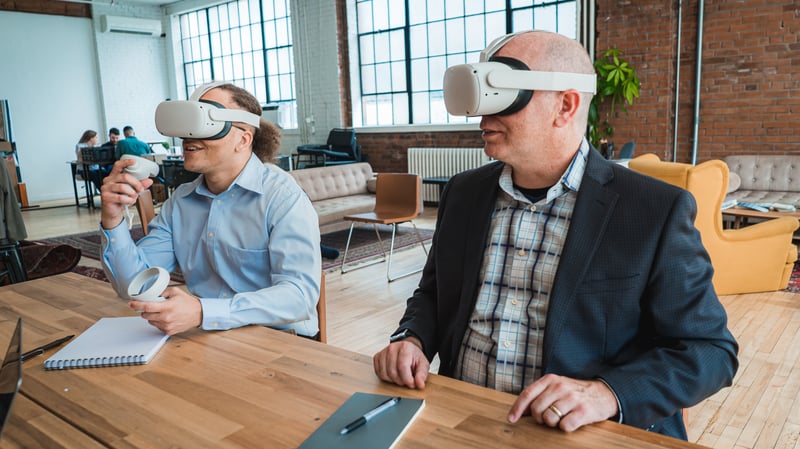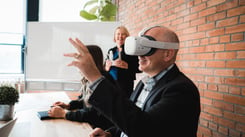Most pieces of software and tech are designed to be multipurpose within a business and used across a multitude of departments and positions. We believe the same goes for VR and there are many uses of VR in architecture. Look at any other presentation software and you can see uses for it in almost any department. VR is the next stage of presentation software, especially when it comes to the architecture and design industries.
We want to break down how VR can be an asset to any department within a design business or architecture firm and give you an idea of how you can start implementing the tech into your organization. We hope that you will be able to see the versatility of the tech and can create a clear plan to incorporate and take full advantage of the many uses of VR in architecture including how you can use Yulio VR.
VR and Sales and Pitches – Sell the Best Image with VR
A sales team that must create presentations to showcase their designs and win pitches can benefit from implementing VR at some point in their sales process. Even in a retail setting, adding space for consumers to experience part of your design through VR can create a memorable experience.
When pitching a design to a client, doing so through VR can go beyond traditional visualization methods by giving clients the closest possible experience to seeing your design in real life. It opens them up to a better understanding of your design and they can mention questions that might not have come up through other visualization methods that can help ease the design process for your design team. Along with all this, a VR presentation will often get your client up and moving in whatever space you are presenting in. This means a more actively engaged audience. If you are looking for more tips on how to present with VR, we have several resources that can help you get started.

To provide some numbers, according to a 2021 survey by e-commerce technology company Zakeke, 41% of consumers are looking for a shopping experience with greater personalization. Going further, 32% of consumers want to be able to customize products in VR. While this study has focused on retail, these numbers still show that when it comes to committing to larger purchases or projects, being able to customize and view a finished product through VR is seen as extremely beneficial by most people.
The Design Team – Visualize Ideas in New Ways
As we mentioned previously, VR is a terrific way to visualize a design and go beyond traditional visualization methods. This is especially true for your design team. They can easily check to see how their designs will feel in a more lifelike setting when viewed in VR. If they were to upload and view their design on a VR device, they can check to make sure things feel properly scaled. That it matches the aesthetic design they are going for. Or if any questions would be raised by a client viewing the design for the first time.
Design teams can work closely with sales teams on VR designs to make sure that they are presenting their concept in the best way possible and creating an active, engaging experience for first-time viewers, such as prospects or customers. Design teams can also modify a VR design using Yulio to add information about why they chose certain materials, or even offer multiple choices for certain products, finishes, or structural choices. They can even add behind-the-scenes information about things such as wiring, smart tech infrastructure, or cable management.
Yulio VR Software offers the option to create several different versions or layers of a VR design, which can highlight various aspects of the design or unique design choices (furniture configurations, finishes, etc.). VR is a fantastic way to pack a lot of information into an easy-to-understand and engaging experience.
Marketing – Create Experiences to Educate and Explore
While the marketing team may not have experience with design, they can easily utilize VR experiences to educate the target audience of your organization. We are sure your marketing team is always looking for updated content and exciting projects that they can share publicly with those who might be interested in using your organization or service.
By having a VR experience about your designs and projects and how exactly they can meet your client’s needs, they can easily take that VR project and find ways to share it with your audience. This could be in terms of social media, blogs, or websites. Any way that they can show your designs to as many people as possible. The key is to have a VR experience that is extremely accessible and educational to make the most impact on a large group of people from varied backgrounds.

Decision-makers – have easy to share content with other decision-makers
Decision-makers, much like your marketing team, are always looking for examples and pieces of content that they can share with other decision-makers or other higher-ups from different organizations. They want something that can best showcase their organization and give an idea of what they do. Again, this is a great chance to have a piece of VR content that is extremely accessible and that they can share with anyone. This can help enhance their “elevator pitch,” as well as just break down communication barriers that may arise when someone does not have a total understanding of the technology.
We should also mention in the cases of your marketing team and in terms of your decision-makers, that we are not expecting everyone to always have a VR device on them. At least have a way that you can share in VR project that they can go back to later and view through something such as a web browser or even their smartphone. For example, we have something called a fish tank view here at Yulio, that allows someone to view a VR project right on their desktop or even on a smartphone/tablet.
Always a place for VR
We hope that we have shown you that there is always a place for VR in any department of your organization or business. Tech is supposed to be multi-purpose and we believe that is the case for VR. Here at Yulio, we have seen many different departments take advantage of the software/tech to enhance how they can present, share, and collaborate with others in their industries, as well as their clients.



.jpg?width=245&height=150&name=apple-business-computer-connection-392018%20(1).jpg)
.jpg?width=245&height=150&name=BUSINESS%20READY%20VR%2046%20(1).jpg)
.jpg?width=245&height=150&name=martin-sanchez-703925-unsplash-e1535118638931%20(1).jpg)
